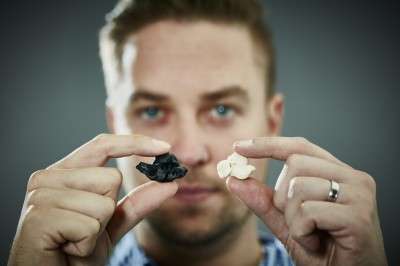Credit: Ben Healley
Scientists have known for decades that modern-day dolphins are some of the most intelligent and social animals on earth. Demonstrating complex behaviour and communication dolphins remind us of ourselves while living in a radically different environment.
But millions of years before humans walked the earth, dolphins evolved their own complex sensory system and communication unique in the animal kingdom.
Modern dolphins and other toothed whales (a group known as odontocetes) use complex sonar frequencies or "echolocation" to communicate with each other, navigate the deep seas, and to hunt their prey. They are the only marine mammals who have developed the ability to hear and analyse such high frequency sounds.
But when did this incredible ability to sense their world evolve? The question has long been a major biological mystery– which a team of scientists from Monash University and Museum Victoria have now solved in a major paper published in the Royal Society's journal Biology Letters.
By borrowing a fossil ear bone of a xenorophid (one of the earliest odontocetes) from the Smithsonian Institution's National Museum of Natural History, the team utilised cutting edge CT scanning technology to 'see inside' the 26 -million-year-old fossil in incredible detail. The results were nothing short of extraordinary.
"When I first looked at the inner ear of the xenorophid, I was blown away by just how similar this incredibly old toothed whale was to a modern echolocating dolphin" explains Travis Park, PhD student at Monash University and Museum Victoria, and lead author of the new study.
This means that even the most ancient ancestors of today's toothed whales and dolphins had ears tuned for hearing high frequency sound, and therefore the ability to echolocate like their living relatives.
This is a major discovery that helps us to understand the timing of the appearance of echolocation, considered to be an essential ingredient in the evolutionary success of odontocetes - allowing them to spread to all corners of the globe and becoming the most diverse of all marine mammals in the process.
But the team's findings highlight a tantalising question, as Dr Erich Fitzgerald, Museum Victoria's Senior Curator of Vertebrate Palaeontology and co-author of the study, explains.
"Our paper shows even the earliest known fossil odontocetes have all the tools for echolocation seen in living dolphins. But they must have evolved from something that didn't quite have all the tricks of the odontocete trade. What were those animals like and how did they start down the path to sonic supersenses? The quest for the origins of this extraordinary group of creatures continues."
More information: Travis Park et al. Ultrasonic hearing and echolocation in the earliest toothed whales, Biology Letters (2016). DOI: 10.1098/rsbl.2016.0060
Journal information: Biology Letters
Provided by Monash University























